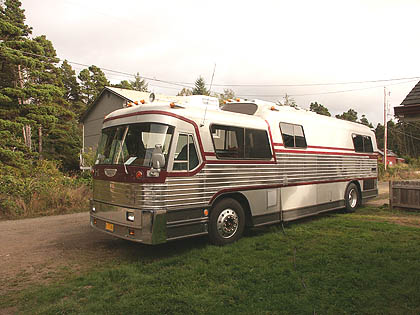
It’s no secret that we are in the midst of a cross country hunt for a converted vintage bus to make our next technomadic home.
But… why?
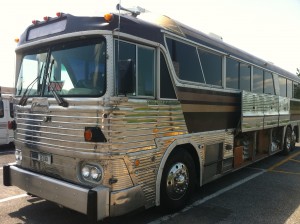 Why a bus? Why not a more traditional RV?
Why a bus? Why not a more traditional RV?
And why vintage? Why on earth would we consider buying a vehicle potentially older than we are?
How did we go from living in a 17′ ultra-modern fiberglass egg to considering life in a 35′ steel box that might have originally hauled passengers in an era before the interstate?
The answers are simple – the nostalgia and uniqueness sounds like fun, pursuing something new (eer.. old?) is certainly exciting, and so far life in a vintage bus seems likely to be a surprisingly practical choice as well.
New Challenges
Our Oliver trailer was a great go-nearly-anywhere pod. It was small and autonomous enough to go places that few other RVs would dare venture.
And we loved occasionally doing just that. We grew proficient at camping on city streets to remote boondocking spots. From urban Walmarts to state parks. Whether months in a commercial RV park, or weeks without hookups – we could thrive with it.
And we got good at it. So good that life on the road in our Oliver was starting to get too easy, and too routine. The negative sides of RVing were starting to show their edges.
We thought about taking on a substantial new challenge in the Oliver, such as heading into Mexico or even Central America. Or up to Alaska. But the more we thought about it, the more we realized that we were ready for something entirely new, and not just a new destination. We have discovered that we both enjoy changing up our physical home, as much as our view.
For a long while, we’ve contemplated live-aboard sailing. But it is more and more seeming like a huge challenge to take on at once, requiring a substantial bulk of our savings to get started and even more so to maintain. And it would be especially challenging to maintain connectivity and keep up our online careers as we adapted.
Sailing remains a future goal for us, but we have decided it’s something for the more far off future rather than sooner.
And after our winter in St. John, we’d also like to start having flexibility to explore future such adventures around the world while maintaining a mobile home base in the US.
More Space!
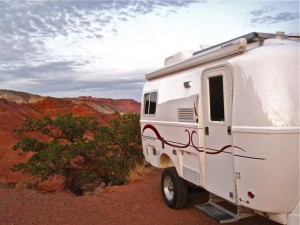 The Oliver was great out in the boonies, where we could make the outdoors our living room. But when we are stopped for longer periods of time in more congested areas, that meant that our “living room” was outside and on display for all our neighbors to see. If we wanted privacy, that meant closing the blinds and sealing ourselves off into a tiny little box. This became less ideal as time went on.
The Oliver was great out in the boonies, where we could make the outdoors our living room. But when we are stopped for longer periods of time in more congested areas, that meant that our “living room” was outside and on display for all our neighbors to see. If we wanted privacy, that meant closing the blinds and sealing ourselves off into a tiny little box. This became less ideal as time went on.
The Oliver also started to present other space issues for us. One thing we greatly miss about our previous stationary lives is entertaining, and the longer we’ve traveled the more folks we’ve met where it would have been nice to have space to host a card game, or offer crash space. The kitchen space also became limiting, and we were craving more agility to let our culinary creativity expand.
Plus, we had a growing cat who wanted her own dedicated nap and play space.
We couldn’t deny it any longer – living in a micro-tiny space had grown old, and we want more space!
The Obvious Choice
The obvious choice, of course, would be to move into a larger RV.
When thinking about trailers – we just couldn’t see any reason to ever want one any larger than our previous Oliver. Besides, we had mastered trailer life – it’s time for something new!
A motorhome felt like a better next step. We looked at some of the smaller motorhomes currently on the market, and there are very limited options.
To put it bluntly, most traditional RV’s are… exceedingly underwhelming to us (no offense to our traditional motorhome living friends).
Most RV’s age poorly, often starting to literally fall apart at the seams within just a few years. It is rare to see an RV more than 10 years old that isn’t ready for the scrapyard. The quality usually just isn’t there – our Oliver was an exceedingly rare exception. We’ve been spoiled. And let’s not even talk about the limited range of style available.
Most motorhomes are built to be as large and lumbering as they can be, yet on the smallest possible chassis. Many designs are overloaded (potentially illegally so) as soon as you fill the holding tanks and load up even minimal gear.
The higher quality motorhomes are priced well above our price threshold. While $125+k isn’t a bad price for a full time house, these RVs will depreciate upon driving off the lot. And it’s certainly more than we’re willing to pay for something we intend to park for 2-4 months a year as we travel abroad.
We want a home that is built to last. With solid bones to carry us. And which is packed with character, style, and grace that reflects our personalities. And we don’t want to tie up a huge portion of our cash in it.
There just wasn’t any way we’d find that on a regular RV lot.
A Bus???
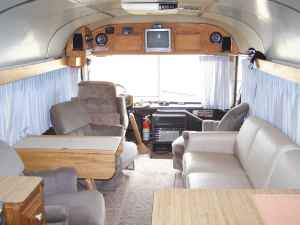 People in the bus community refer to traditional RV’s as “sticks and staples”, and with good reason.
People in the bus community refer to traditional RV’s as “sticks and staples”, and with good reason.
A typical RV is designed to be used a few weeks or months a year, and driven only a few thousands of miles in that time. A bus on the other hand is engineered for constant commercial service – built to carry heavy loads of passengers and baggage, and to go millions of miles.
Buses, by definition, are built to last. And buses being used as RV’s are not being pushed anywhere close to their limits.
The ultra-high-end of the RV market has always used buses as a foundation, with many companies specializing in custom bus conversions catering to a clientele looking to spend whatever it takes to “get the best”. Wealthy retirees, rock stars, and touring bands have all sprung for custom buses, with price tags to match. We’re not that demographic.
Ten, twenty, or even thirty years later, these buses that once cost a fortune are selling used for a fraction of their original cost. But unlike a traditional RV, as long as it was well cared for, an older bus still has a relatively long life ahead of it.
Some of the high-end conversion companies buy virgin bus shells straight from the factory, but other professional conversion companies and talented hobbyists buy buses that had been in passenger service but which were being retired – such as older Greyhounds. Some of the best conversions are the byproduct of a talented hobbyist craftsman spending literal years working to perfect and polish every possible nut and bolt on a hobby bus. Others hobbyist bus conversions are made up of thrown together half-completed projects.
The key is tracking down the jewels and skipping over the potential money pits, or the buses requiring extensive renovation work before they are ready to be lived in.
And the vintage bus market is especially soft right now due to rising diesel prices, the economy and limited (or no) options for financing. With patience and a realistic eye, you can find amazing converted buses in the $10- 30k range. Add in some updates and put aside some cash for anticipated repair & maintenance, and one can end up with a unique longer lasting home on wheels for less than the price of a brand new ‘quality’ RV.
Vintage??
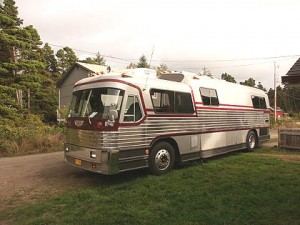 Buses used to look cool – with rounded edges and silver sides.
Buses used to look cool – with rounded edges and silver sides.
At some point over the past few decades buses morphed into sleek but rather dull looking boxes.
Buses also grew bigger, as state laws changed to first allow 40′ lengths and then 45′. Buses got wider too – stretching from 96″ across to a lane-spanning 104″.
For a bus carrying paying passengers, bigger makes sense. But for two nomads used to living in a 17′ egg, the formerly standard 35′ length is already more than enough! We already know that most RVs will never be able to go to the remote places we did with our Oliver. However, many public parks that we favor were built in a time before 40′ & 45′ RVs were legal, so they have a 35′ length max to maneuver and park.
After looking at several 40′ and 35′ buses, we simply know that a 35′ bus with 2 axles is what we want. Anything bigger is just too much for us.
Vintage buses do have their challenges however. While the diesel engines of these things were fairly standard for buses, trucks, boats and more – some of these buses just have parts that are made of unobtanium. And of course, time is not always kind. Corrosion and rust are issues to be on the look out for.
Hopefully we’ll be able to find a bus that hits a sweet spot – old enough to be stylish and affordable, but updated enough not to be a maintenance migraine.
Practical & Challenging
The more we’ve researched bus life, the more the idea has grown on us.
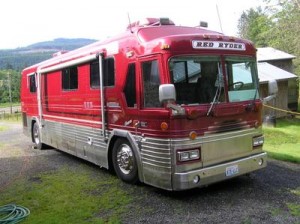 From a practical angle, it just makes sense…. By buying an older bus conversion, we can get an longer lasting RV for a fraction of the cost of a new (or even used) “sticks and staples” design, and we will get something that is stylishly uniquely ours and a great foundation for our own geeky customizations.
From a practical angle, it just makes sense…. By buying an older bus conversion, we can get an longer lasting RV for a fraction of the cost of a new (or even used) “sticks and staples” design, and we will get something that is stylishly uniquely ours and a great foundation for our own geeky customizations.
And as a bonus – learning bus systems and diesel engine maintenance is perfect training for our eventual life at sea! We look at our vintage bus experiment to be training wheels for sailing life – learning to deal with challenges of upkeeping systems in circumstances that might be challenging … without risking sinking or floating adrift at sea.
Now all we need to do is scour the country, and find the right bus for us!
Got a 35′ bus to sell? Fill out our information form to let us know about it!

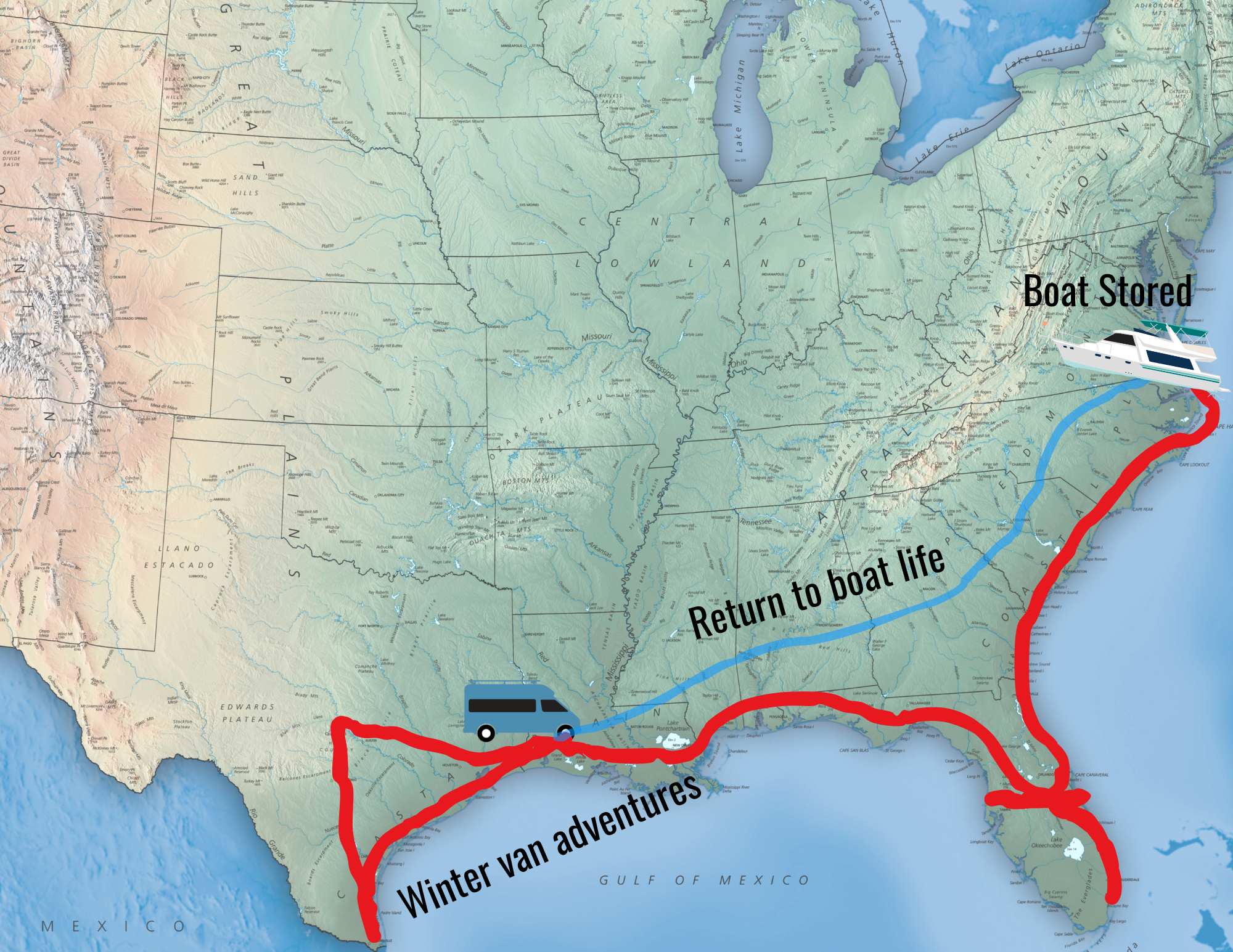
Hello ive recently started looking into vehicle conversions since ones like winnebago are just to fragile for my needs and stick and stone home seems like a death sentence so on practicalness here im looking for something that can hold a generous water and at least decent waste tank with still room for one bed bathroom plus shower kitchen and washer and dryer. And maybe a small living room. This would be for 24/7 year round living in. Thats why large water tanks. What would you recommend? I would at some point add or try to add solar paneling and such to make it more lasting, basicaly a preppers dream mobile command seems like a good description. Apologies for this long post question im quite new to this with no experience but any tips or advice would be greatly appreciated!
Converting a bus can certainly meet your desires. Recommend continuing your research to find the right solution for you. http://www.busconversions.com is the go-to community for such things.
Hello Chris and Cherie. We hope you both are good and healthy. For we found our bus and hope to have it ready by the end of 2017. We’ve been collecting many types of wines and spirits. We r looking forward and excited about finally meeting the both of you, with a few “liquefied” gifts! Please keep on “bus-sing” !
Collette and Marvin July
Hey! My wife and I are looking for a ” Vintage Bus ” like a 4104, ’62 or older to go on the road in. We see what’s online, but have not been aboard any. Here’s the question; In your search, did you actually go aboard or make a decision by photo? If they only have one pic, we go no further. Love the blog!
Wayne
Definitely recommend looking at them in person. Each one is so completely unique. Make sure you also look at our ‘Bus Dating’ and other posts during our shopping experience.
Keep enjoying life and being a blessing to your followers and readers! God’s love, safety, and a great time with your future bottle of wine…
I have come to the same conclusion about getting a bus motorhome conversion. It is still some years off before we can get one. I am in the process of learning as much as I can about them. Someday, when we are semi-retired I would like to do volunteer building and disaster relief. You cannot haul around a half-ton of tools in a trailer or motorhome, but a bus can. I too am looking for a vintage one, they are way cooler than the boxes on wheels of today. I run a Facebook group called Vintage Motorhomes. Bus motorhome conversions are welcome. In face I am going to link this article on the wall. I am interested in what you end-up buying. Perhaps you can join Vintage Motorhomes and post the bus conversions that you pass-up. Thanks. Happy Camping!
Hi Roger… and welcome. this post is actually 2.5 years old, and we’ve been on the road in our bus conversion since June 2011.
Here’s what we ended up with: https://www.technomadia.com/zephyr
At the bottom of the page are links to more posts about our bus hunt (including buses we passed up, but most have been sold by now), and the continuing story of our bus related projects.
Just found you for a second time and can tell you that a bus conversion is wonderful! We did our own of a Southern Coach Mfg. Co. bus built in 1955 and converted 1977-1982.
We were still in the work force and had only some evening hours and week-ends but it was SO worth our time. We have been over the Rocky Mountains many times and many states in the lower 48 with NO problems! Are still using it but are at our “slowing-down-time” and plan to sell it. Hate to do so! Best camper we ever owned! Did it our way……………
I am now looking for a converted bus to fulltime. please call when ready to sell 2 zero 1 – four 88 – four six 73.
Stacie
Wow! Didn’t even know such things existed but it just makes sense. Some of those vintage buses are so pretty I can see why one would be drawn to them. Can’t wait to see how the finish product!
I have to admit those old buses have sure got some beautiful lines. Will be looking forward to following along w/ your journey on this conversion. One day we’ll downsize from “the beast” and would like to consider something more vintage.
Nina
My girlfriend and I are planning to spend a good chunk of time living on the road after we finish the jet setting phase we’re in right now. I looked at some traditional RVs and yeah, most of ’em seem pretty flimsy. I’ll be following your quest to find a bus with great curiosity…
Have you guys talked to Nick Russel at Gypsy Journal? (http://gypsyjournal.net/about_the_gypsy_journal.htm)
Nick and Terry built and drove a bus conversion for years and may have some good insight on the subject.
John
Thanks for the reminder of that! We have talked to him on other RVing stuff, but had forgotten he was a but nut!
We are looking at converting a bus also. Right now it is still in dream phase but we are talking about doing the conversion ourselves (my husband is a carpenter) Buying a composting toilet so we won’t have to sani-dump, getting solar panels, and converting it to run on Veggie Oil. I’ll be watching your journey with interest!
Very cool.. good to know there are others currently considering similar routes. Best wishes in your eventual search. There seems to be tons of great options out there for these buses.
Best wishes in your eventual search. There seems to be tons of great options out there for these buses.
Oh what a wonderful project guys! Do go for a vintage diesel bus!( Oh the wonderment of having a nice diesel-bus without any Ignition-computer crap on it).
There certainly do seem to be advantages of a simple diesel 2-stroke system in maintaining them. And there do seem to have some unique challenges, as 2-stroke mechanics are ending their careers as well.
I can’t wait to see what you end up with. Terry and I always drool over the vintage buses we see anywhere. We will hang a u-ey immediately to go oogle one parked with a For Sale sign on it!
Our 1978 Holiday Rambler that we are repurposing has been a joy – MUCH better insulated and well-built than our 1996 fifth-wheel was. After 30+ years and some systems repairs/replacements along the way, she is still strong and always ready to go.
Reading your blog really makes us want to become bus-nuts too, when we are ready to “kick it up a notch” and go to a larger, more full-time RV.
Vintage is becoming the current “cool” in RVing …. and you two are way-cool … or is that “bad” nowadays?! Anyway enjoy, we are hanging on every post.
Thanks for the vintage bus encouragement! It does certainly seem like older RVs in general were just built to last longer than they are nowadays. Glad to hear your Rambler is still full of life!
Chris & Cherie
You will love a bus. Our family converted our bus six years ago and it has provided many fantastic memories. It is like having a beach house on wheels.
You will need to modify your definition of “getting there” when in a bus. We now consider any drive-thru parking spot within two blocks of our destination as being able to “get there”. Parking in the far reaches of a Wal-Mart lot and walking in is also normal.
The diesel pushers are quiet while driving and even quieter while sleeping. The 35ft length is ideal for city driving and the backroads. Consider the overall height and try to stay under 12 feet. I have not encountered an overhead obstacle on the road lower that 12 feet, but I have at campgrounds.
Another consideration is undercarriage clearance. Our school bus has almost two feet of clearance under the body. This has allowed us to get down some very back roads and into some primitive campsites. The highway buses you are considering will have much less ground clearance and will limit some of your routes and destinations. But for planning purposes any modern roadway will accommodate a motorcoach.
Everything about a bus is better than a typical RV. The body is stronger. The drivetrain is more robust. The electrical and lighting systems are standardized, and parts are available at almost every truck stop. When comparing a bus to an RV motorhome the maintenance is no different except more truck repair shops will be willing to work on a bus.
My last two cents worth of advice is to practice driving it in a safe area. Really. Don’t head out for St Louis right away. Highway driving is not practice. Go somewhere you can practice turns and backing up.
The drivers seat on most buses is six to eight feet in front of the front tires. That makes for a very unusual turning experience. The rear bumper is eight to twelve feet behind the rear tires and will swing out when making a tight turn.
You guys will figure it out. I am looking forward to seeing what you select. It will be cool I am sure of that.
God speed.
Thanks for the tip on the height, that’s a good benchmark for sure. We definitely want to keep accessible for state parks and such, and is a big driving force behind staying at 35′ and below. We have already given up option of the more remote off road ability we had with our trailer set-up (and considering eventually towing a 4×4 Jeep for those explorations.)
We definitely plan to spend time getting comfortable driving the bus locally before heading back to St. Louis to get Kiki. We did get some time behind the wheel this week, and it was reinforcing that it’s not as intimidating as we initially thought.
Wow! Amazing idea. I can’t wait to see what y’all find and how you end up customizing it.
Thanks for the continued encouragement
This great, vintage bus showed up on another forum, last week.
http://bellingham.craigslist.org/rvs/2419205361.html
I don’t see a bathroom, though
The guy’s inspiration, this video, is epic!
http://www.youtube.com/watch?v=aPhWfSeMYHA
Cyndi & Stumpy @ RVly Ever After
Hah yes.. the video is epic! And we have seen this bus in our searches.
However, we are specifically looking for long range transit buses with underbay storage and highway gearing. Converted school buses and local transit buses aren’t generally making our contender’s list.